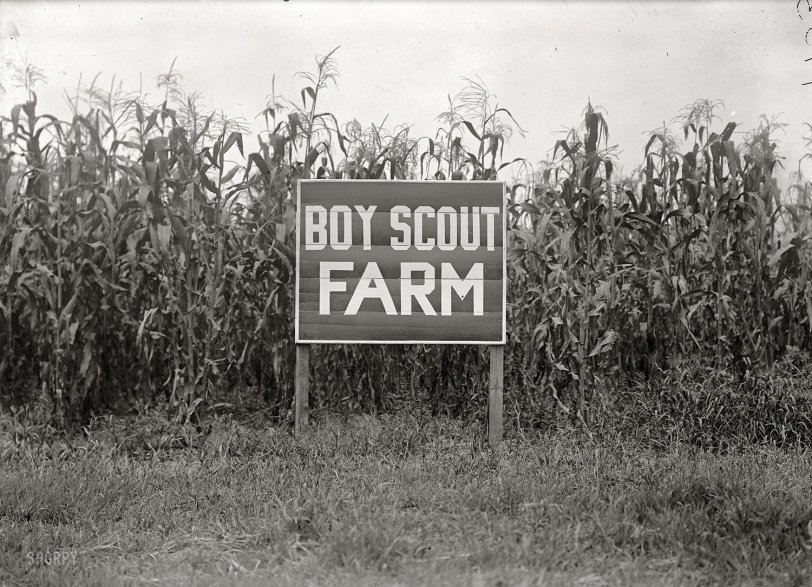


Framed or unframed, desk size to sofa size, printed by us in Arizona and Alabama since 2007. Explore now.
Shorpy is funded by you. Patreon contributors get an ad-free experience.
Learn more.

- Texas Flyer wanted
- Just a Year Too Soon
- WWII -- Replacing men with women at the railroad crossing.
- Yes, Icing
- You kids drive me nuts!
- NOT An Easy Job
- I wonder
- Just add window boxes
- Icing Platform?
- Indiana Harbor Belt abides
- Freezing haze
- Corrections (for those who care)
- C&NW at Nelson
- Fallen Flags
- A dangerous job made worse
- Water Stop
- Passenger trains have right of way over freights?
- Coal
- Never ceases to amaze me.
- Still chuggin' (in model form)
- Great shot
- Westerly Breeze
- For the men, a trapeze
- Tickled
- Sense of loneliness ...
- 2 cents
- Charm City
- What an Outrage
- Brighton Park
- Catenary Supports
Print Emporium
Growing Boys: 1917
Food Bullets
The Boy Scout Farm was located at the site of today's East Potomac Park.
Start Boy Scout Farm
More Than 500 District Lads
Open National Food Campaign.Spurred on by the admonition of Assistant Secretary of Agriculture Carl Vrooman that "the boys in the furrow will be winning the war before the boys get in the trenches." More than 500 Boys Scouts of Washington yesterday started the cultivation of a 300-acre farm along the Potomac.
Uniformed in khaki and marching like soldiers, but armed with the rake, hoe and other gardening implements, Washington's first army of volunteer farmers went to the bat for the allies yesterday by going into the furrows.
This marked the opening event of the national campaign to be waged by the national emergency food garden commission. The first "battle" in Potomac park was marked by intense patriotism.
The army mobilized at Fourteenth street and Pennsylvania avenue shortly before 10:30. Escorted by mounted police and headed by bicycle troop, with a Boys Scout band, the boys marched to New York avenue, west to Pennsylvania avenue. They passed the white house where they were greeted by President Wilson, returning in an automobile from a golf game. Secretary Tumulty came out of the executive offices to watch the army pass. Passing down Seventeenth street, the procession was witnessed by Secretary of War Baker and other officials, who watched from the porches.
At the Department of Agriculture the scouts broke rank to hear an address by the Assistant Secretary of Agriculture.
He told the boys that for many months the only bullets can shoot are "bread bullets and food bullets." While we are preparing our army, the English, French and Russian soldiers are offering their lives in our defense, he said, and the only way we can return this now is with food. The boy's work, he continued, is a valuable, significant, and as indispensable as that of any soldier of the United States. The work they are starting, Mr. Vrooman said, "Is only a part of the national plan to have one company working the furrows, for every company in the trenches. He said we would not be surprised to see the boys in the furrow win the fight before the others fired a gun.
...
The gardeners received 100 pounds of seed from F.W. Bolgiano. They carried rations, and after noon, pitched tents and proceeded to eat their lunches. The campaign thus started will continue throughout the summer.Washington Post, April 22, 1917
Children of the Corn
Seems during the war, Scouts helped out producing food for the war effort:
In 1917 Boy Scouts operated a Government-owned tract of 175 acres and raised a corn and market vegetable crop worth some $10,000. The land was in a wild state — a tangle of wood and shrubbery when the boys attacked it. They cut down trees, cleared the brush, pulled the stumps and roots, prepared the soil, planted, cared for, and harvested the crop themselves and all the work done was purely voluntary, devoted to soldier feeding, not to gain.
So that's what people mean
... when they say "my boys are grown." Especially Scouts, who are so fresh and wholesome. And maybe a little green -- wet behind the ears.
Unfortunately...
...all the scouts made little Anthony mad and got wished into the cornfield.

























On Shorpy:
Today’s Top 5